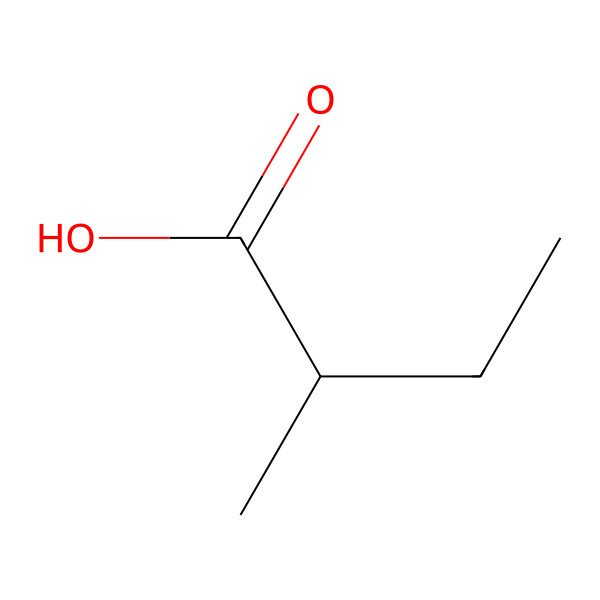| 2-METHYLBUTYRIC ACID |
| 116-53-0 |
| DL-2-Methylbutyric acid |
| Butanoic acid, 2-methyl- |
| Ethylmethylacetic acid |
| Methylethylacetic acid |
| 600-07-7 |
| 2-Methybutyric acid |
| Carbomer 934 |
| Active valeric acid |
| Butyric acid, 2-methyl- |
| alpha-Methylbutyric acid |
| Valeric acid, active |
| 2-methyl-butanoic acid |
| FEMA No. 2695 |
| Butanoic acid, methyl- |
| alpha-methyl butyric Acid |
| Methylbutyric acid |
| NSC 7304 |
| 9007-16-3 |
| 2-Methylbutyric acid (VAN) |
| Carbopol 934 |
| Carbopol 974P |
| (+/-)-2-Methylbutyric acid |
| 2-Methylbutyric acid (natrual) |
| 2-methyl-butyric acid |
| PX7ZNN5GXK |
| UNII-PX7ZNN5GXK |
| EINECS 204-145-2 |
| EINECS 209-982-7 |
| .alpha.-Methylbutyric acid |
| (1)-2-Methylbutyric acid |
| BRN 1098537 |
| DL-2-Methyl-d3-butyricAcid |
| AI3-24202 |
| DTXSID5021621 |
| CHEBI:37070 |
| (S)-(+)-2-MethylbutyricAcid-d3 |
| 2-METHYLBUTANOIC ACID (DL) |
| NSC-7304 |
| EC 204-145-2 |
| 4-02-00-00889 (Beilstein Handbook Reference) |
| DTXCID301621 |
| (R)-2-Methylbutyric Acid-d3 |
| Methylbutyricacid |
| CAS-116-53-0 |
| (+)-2-methylbutanoic acid |
| Carpolene |
| Texcryl |
| Arolon |
| Racryl |
| Tecpol |
| Solidokoll N |
| GC Conditioner |
| MFCD09029093 |
| Ethylmethylacetate |
| cavity conditioner |
| Sokalan PAS |
| 2-Ethylpropionate |
| G-Cure |
| 2-Methyl Butyrate |
| carbomer-934 |
| Methyl butyric acid |
| Pemulen TR-1 |
| Pemulen TR-2 |
| 2-Methylbutanoicacid |
| Antiprex 461 |
| Carbomer 910 |
| Carbomer 934P |
| Carbopol 910 |
| Carbopol 961 |
| Carbopol 980 |
| Haloflex 202 |
| Haloflex 208 |
| MFCD00002669 |
| Arasorb 750 |
| DL-2-Methylbutyrate |
| Carbomer 1342 |
| Carbopol 1342 |
| Good-rite K727 |
| 2-Ethylpropionic acid |
| Arasorb S 100F |
| D-2-Methyl Butyrate |
| D-2-Methylbutyricacid |
| Good-rite K-700 |
| DL-2-Methy Butyrate |
| PAA20 cpd |
| PAA60 cpd |
| Colloids 119/50 |
| DL-2-Methylbutyricacid |
| Neocryl A-1038 |
| 2 - methylbutyric acid |
| ethyl methyl acetic acid |
| butane-2-carboxylic acid |
| rac-2-methylbutanoic acid |
| D-2-Methyl Butyric acid |
| DL-2-Methy Butyric acid |
| 2-METHYLBUTYRICACID |
| Carbomer 934 [USAN] |
| Carbomer 940 [USAN] |
| Carbomer 941 [USAN] |
| Carbomer 934p [USAN] |
| (+/-)-2-Methylbutyrate |
| (+-)-2-methylbutyric acid |
| SCHEMBL49960 |
| 2-Methyl-Butyric Acid Anion |
| 2-Methylbutyric acid, 98% |
| Nat. 2-Methyl Butyric Acid |
| (RS)-2-methyl-butyric acid |
| MLS001055480 |
| METHYL-2-BUTYRIC ACID |
| Carbomer 934 [USAN:NF] |
| CCRIS 3234 |
| PAA170 |
| CHEMBL1160012 |
| NSC7304 |
| (.+/-.)-2-Methylbutanoic acid |
| HMS2270O06 |
| 2-METHYLBUTYRIC ACID, DL- |
| 2-METHYLBUTYRIC ACID [FCC] |
| 2-METHYLBUTYRIC ACID [FHFI] |
| NATURAL 2-METHYLBUTYRIC ACID |
| Tox21_201807 |
| Tox21_303584 |
| LMFA01020072 |
| 2-Methylbutyric acid, >=98%, FG |
| Butanoic acid, 2-methyl-, (+ -) |
| DL-.ALPHA.-METHYLBUTYRIC ACID |
| AKOS000121120 |
| AKOS016843247 |
| Butanoic acid, 2-methyl-, (.+.)- |
| Butyric acid, 2-methyl- (6CI,8CI) |
| CS-W001942 |
| LS-2915 |
| NSC 106034 |
| NSC 106035 |
| NSC 106036 |
| NSC 106037 |
| NSC 112122 |
| NSC 112123 |
| NSC 114472 |
| NSC 165257 |
| SB47880 |
| TB 1131 |
| (+/-)-2-METHYL BUTYRIC ACID |
| (.+-.)-2-METHYLBUTYRIC ACID |
| NCGC00090971-01 |
| NCGC00090971-02 |
| NCGC00257513-01 |
| NCGC00259356-01 |
| 2-Methylbutyric acid, analytical standard |
| AM802977 |
| PD041098 |
| SMR000112113 |
| SY115833 |
| BUTANOIC ACID, 2-METHYL-, (+)- |
| FT-0604458 |
| FT-0605255 |
| FT-0608333 |
| FT-0671578 |
| FT-0671579 |
| M0181 |
| EN300-27063 |
| C18319 |
| Q209433 |
| J-509893 |
| (+/-)-2-Methylbutyric acid, natural, >=98%, FG |
| F0001-0289 |
| Z237374874 |
| The viscosity of a neutralized 1.0 percent aqueous dispersion of Carbomer 1342 is between 9,500 and 26,500 centipoises |
|
There are more than 10 synonyms. If you wish to see them all click here.
|
